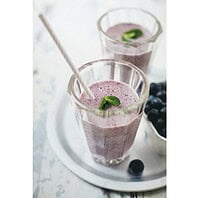
It’s nothing new on the diet scene, but intermittent fasting is getting a lot of press recently, with people achieving amazing weight-loss results by limiting the hours they eat for. The 5:2 Diet, Eat Stop Eat method and the Warrior Diet are all slight variations on this method, but the variation that’s caught my attention is the Leangains method, where you only eat within an eight to 10-hour period (or even less) and fast for the remaining 14 to 16 hours, to encourage your body to draw upon its fat supply for energy.
THIS POST CONTAINS AFFILIATE LINKS

Leangains: Intermittent Fasting
How does it work?
It’s very simple! Rather than spreading out your meals from the moment you wake up to the time you go to bed, you extend the ‘fasting period’ beyond your sleep hours and into the day. A good starting point is to fit your meals into a 10-hour window; so have breakfast at 8am and finish your dinner by 6pm, or have brunch at 10am and finish your dinner by 8pm. The next step would be to narrow this by a further two hours, so have brunch at 11 or 12 and dinner by 7pm or 8pm, and then fast outside of these hours.
In my research I came across this video by Sarah Cheung where she talks about losing 30lbs through intermittent fasting, and she gives some really useful tips and advice.
I’ve been giving intermittent fasting a go for a month or so, so I’ll keep you posted with my results, but I’m finding it easier as time goes on to stick to the fasting windows.

I spoke to nutritionist Kim Pearson to get her thoughts on intermittent fasting, and she had this to say…
What are your thoughts on intermittent fasting as a weight loss method?
Some studies have found that intermittent fasting can be as effective as continuous calorie restriction for weight loss. There are two primary methods of intermittent fasting. One method involves fasting completely, consuming nothing except water for 24-hours, on one or two non-consecutive days a week. The most common method is the 5:2 diet approach. This involves consuming only 500 calories for women, or 600 calories for men calories per day, on two non-consecutive days per week. There is no restriction on food intake for the remaining days of the week. If adopting the 5:2 diet, the person fasting needs to understand the calorific values of the foods they are consuming. This often results in an increased awareness that positively influences food choices on non-fasting days. I believe is one of the reasons it can have such a positive impact on weight!
Who is it suitable for, and who should avoid it?
If you’re looking to lose weight and feel that this approach could suit you and your lifestyle, it’s worth trying. Anyone with an active infection or disease, a history of syncope (fainting), those taking regular prescribed medication and pregnant women should not go for extended period of time without eating unless specifically advised to by an experienced healthcare professional. Fasting is not recommended for anyone with an eating disorder.

What sort of meals would work best for the periods between fasting?
When restricting food intake, you’re also limiting the opportunity to consume essential nutrients such as vitamins, minerals, antioxidants, essential fats and fibre. Therefore, it’s important to ensure that the general diet is as nutrient dense as possible. Balanced meals should be based on plenty of fresh vegetables, as well as sources of protein and fat. Quality protein sources include fish, seafood, eggs, tofu as well as a little organic meat. Protein is essential for supporting our skin (collagen and elastin are proteins) and muscle mass as well as keeping us satisfied. Plenty of vegetables and a little fruit provide essential micro nutrients, such as vitamins, minerals and antioxidants. to keep our bodies healthy and our skin glowing. In order to reduce body fat effectively we still fats in our diet so don’t be tempted by out dated low fat diets. Consume moderate amounts of healthy fats from foods like olive oil, nuts, seeds and avocado.
In addition to adding in healthy, nourishing foods, there are a few things to avoid too. Sugars, sugary foods and refined carbohydrates (such as bread, white rice, white noodles and pasta etc) promote weight gain. Watch out for foods marketed as ‘healthy’ such as granola, cereal bars, low fat foods, often these foods are secretly high in sugar. It’s also wise to consider taking a good quality multivitamin, vitamin D and omega 3 supplement.

Anything else to be aware of with fasting?
There are a number of different approaches to fasting and calorie restriction. Leading experts in the field of fasting and health believe that, while time restricted eating and intermittent fasting can improve certain aspects of health, this is not actually true fasting. In order to experience benefits such as autophagy and increased stem cell generation, you would need to do a water only fast, or fast mimicking diet, for a minimum of three to four days.
There is no one size fits all approach to fasting or calorie restriction. It’s important to find an approach that is healthy and works for you.
The important thing to remember is to take it slow, and don’t make changes too drastically, and if you have health problems or any doubts at all that this might not be right for you, speak to your doctor before you give it a go.
Watch the video from Sarah, and for some healthy meal ideas of what to eat for the meals in between fasts, check out my book Eat Beautiful.
READ NEXT: Kale Soup Recipe | Pomegranate Salad Recipe
© Wendy Rowe. All Rights Reserved.












